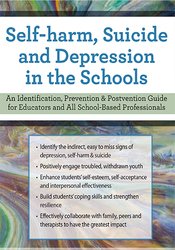Suicide and Non-suicidal Self-Injury (NSSI)
- The relationship between suicide and self-injurious behavior
- When clients present with depression, anxiety, trauma
- Confidentiality, documentation, and legal considerations
Assessment Tools for Adolescents
- Formal assessment tools for NSSI
- Recency and frequency
- Severity
- Triggers
- Who’s aware
- Suicide risk assessment
- SAFE-T
- C-SSRS
- Ideation, plan, means, intent
- Level of risk, intervention and when to hospitalize
Motivational Interviewing Techniques That Engage Young People in Treatment
- Tips to quickly establish rapport
- Using the Stages to Change/Motivational Interviewing Model in Treatment
- Overcome therapy interfering behaviors
- When parents are ready for change NOW!
Adapt DBT for Use with Adolescents
- Track suicidal and self-harming urges with diary cards
- Reduce emotional reactivity and improve distress tolerance
- Identifying emotions and triggers
- Mindfulness practices and relaxation techniques
- Reproducible handouts and checklists
CBT Interventions to Build Coping Skills and Manage Crisis
- "Thought flipping" to maintain positive focus
- Address body image issues
- Create opportunities to build resilience, self-efficacy and self-control
- Handle suicidal crisis – self-soothing and distraction techniques
Effectively Work with Parents, Peers and Schools
- Interpersonal effectiveness skills for adolescents
- Training exercises to convey feelings/read the feelings of others
- Integrate parents into treatment
- Parental behaviors that can do more harm than good
- Means restriction strategies for safe home environments
- Involve schools and peers
- Learn to build “Trusted Adult” support networks
- Peer education approaches that create support
- Minimize the impact of bullying





